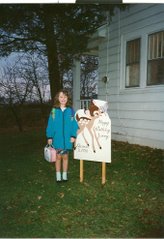Personal Learning Goal: To not give in to peer pressure.
Objectives: (Attitudinally based, and skilled) After reading the chapter on Social Cognitive, I will watch to see if I give into peer pressure, or I am the individual that follows my own path.
Methods: To see if I give into peer pressure I will reflect on the day in my journal and write down every event and action I do. This will help me to realize if I would have made these choices on my own or if peer pressure played a part.
Assessment: I know going into this week will be a little bias, but hopefully as the week goes on, I will live my life normally and not think too much on whether what I am doing is under peer pressure or not. After reading through my journal I realize that out of the five days (Monday-Friday), I fell under major peer pressure on Wednesday on my good friends birthday, but all most everyday I did something that I would not have done if I was not asked. These events were not always bad. On Thursday, I studied with a bunch of my friends, and was able to do a lot of homework. But on Wednesday, the traditional negative peer pressure came in to play when I went to a movie, and out to eat for dinner, and then watched a movie in my dormroom with my roommate and neighbor.
Reflection: According to Woolfolk there are many theories of social cognitive. During my week of observation, I realize that what made me pick the activities and events to go to were based on reciprocal influences from D.H. Schunk. Reciprocal influences are three forces-personal, social/environmental, and behavioral-are in constant interaction. They influence and are influenced by each other (330).
Wednesday, April 11, 2007
Wednesday, April 4, 2007
Weekly Reading Reflection Chapter 10
Personal Learning Goal: To see if children need to be motivated to do everything
Objectives: (Attitudinally based) To use motivation in the field and see what form of motivation works the best
Methods: By taking annotated notes of children's reactions and performances I will be able to write a non biases report on how the children reacted. This will reinforce my learning from Woolfolk because I am a visual learner and I will have hands on experience to reflect to when I am teaching.
Assessment: I noted that the children, 7th and 8th grade conformation students at a lock-in, were very excited to be their in the first place which would affect whether the children were actually motivated or they were just excited to see what is next. But over all after one of the members on my outreach team set the stage for the activity, the children reacted positively. Watching the children's reactions also showed that the actual motivation was not the only thing that motivated them, but also the actual game. For an example, when the children found out that we are going to play Sardines they were already motivated, and did not need us to motivate them.
Reflection: During our lock-in we used multiple ways to motivate the children. In Woolfolk (374-376) he states that there are four general approaches to motivation. We used mostly behavioral approaches, reward and incentive, cognitive and social cognitive approaches, and social conceptions of motivation. With every motivation we also established goals for them in order for use to direct there attention, energize the effort, increase persistence, and promote the development of new knowledge and strategies (380). Over all I learned through this experience and the reading from Woolfolk that a positive reaction from a motivation has many variables but if done effectively can be more controlled in some ways.
Objectives: (Attitudinally based) To use motivation in the field and see what form of motivation works the best
Methods: By taking annotated notes of children's reactions and performances I will be able to write a non biases report on how the children reacted. This will reinforce my learning from Woolfolk because I am a visual learner and I will have hands on experience to reflect to when I am teaching.
Assessment: I noted that the children, 7th and 8th grade conformation students at a lock-in, were very excited to be their in the first place which would affect whether the children were actually motivated or they were just excited to see what is next. But over all after one of the members on my outreach team set the stage for the activity, the children reacted positively. Watching the children's reactions also showed that the actual motivation was not the only thing that motivated them, but also the actual game. For an example, when the children found out that we are going to play Sardines they were already motivated, and did not need us to motivate them.
Reflection: During our lock-in we used multiple ways to motivate the children. In Woolfolk (374-376) he states that there are four general approaches to motivation. We used mostly behavioral approaches, reward and incentive, cognitive and social cognitive approaches, and social conceptions of motivation. With every motivation we also established goals for them in order for use to direct there attention, energize the effort, increase persistence, and promote the development of new knowledge and strategies (380). Over all I learned through this experience and the reading from Woolfolk that a positive reaction from a motivation has many variables but if done effectively can be more controlled in some ways.
Subscribe to:
Posts (Atom)
